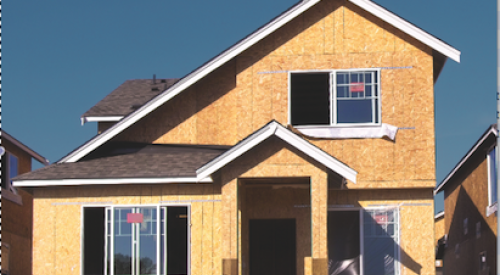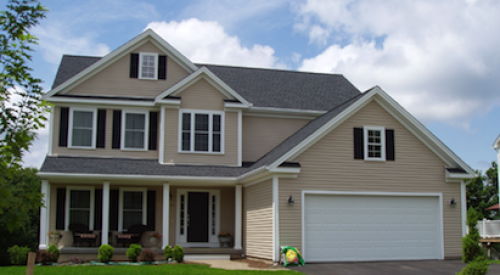| A typical Wathen-Castanos home - the firm sold 240 like this one in 2002. Housing affordability in central California is now hostage to runaway insurance costs.
|
The liability insurance crisis is not new. It has been growing since the economy began to head south early in 2001, and it ripened into real trouble after the events of Sept. 11 sapped capacity from the whole insurance industry. In the West, many builders might say it has been a crisis since the mid-1990s, when the epidemic of construction defect litigation began spreading from California into Nevada, Arizona and Colorado.
However, what gives the current problem depth and staying power is the "double whammy" - the convergence of all the factors that make today's insurance market hard for every executive in every industry with all the factors that make home builders uniquely unattractive, as an investment medium, to insurers who have many alternatives when choosing where to place their coverage.
|
Insurance industry insiders contend that all through the 1990s insurers charged premiums (for all kinds of policies) that were too low to support the risks being insured and that insurers were (and are) under-reserved - without adequate funds set aside to pay anticipated claims. Fueled by the high returns insurance companies were making on investments of premiums income, especially in the stock market, this phenomenon was industrywide, not limited to the small group of insurers writing home builder policies.
As a result, however, the builder segment began to suffer loss ratios far in excess of premiums charged. The average loss ratio in this segment of the insurance industry is now said to be three to four times premiums income.
Also, home builders were not guiltless victims of the excesses of the soft insurance market of the '90s. "Builders got liability policies with virtually no deductibles, and the lines really blurred between what was warranty work and what was an act of negligence that could be an insurance claim," D.R. Horton risk manager Stephan Perison says. "Some builders were handing over what should have been warranty work to their insurance carriers. But premiums were still dropping every year, whether there were claims or not."
It's a fair bet there are builders reading this report who now regret filing so many claims because their claims history is under scrutiny as part of a much tighter underwriting process.
But there was no crisis in the '90s as long as investment income propped up this house of cards. That began to change early in 2001. As the stock market cycled down and double-digit investment income disappeared from insurers' books, the soft insurance market hardened. Then came Sept. 11, and another card collapsed as the reinsurance segment of the industry staggered under catastrophic losses atop the long-smoldering imbalance in loss ratios.
The availability of insurance is driven by the accessibility of relatively inexpensive and plentiful reinsurance, which is the secondary market to which primary insurers move the portion of risk they are uncomfortable holding on their own. Stan Ehrlich, who writes Money Matters for this magazine, points out that for primary insurers, the more premium dollars they pay for reinsurance, the fewer dollars are available for their profit.
The contraction of the reinsurance market was well under way before Sept. 11, 2001. But that tragedy certainly added a kick to the knee of an already-reeling reinsurance sector. The losses associated with Sept. 11 are estimated at $40 billion to $70 billion.
"In the short term, the upheaval in the insurance marketplace has certainly limited the ability of primary insurers to expand or, in some cases, even continue writing policies for high-risk markets like the construction industry," Ehrlich says.
Why Insurers Don't Like Builders
Insurance companies like industries with predictable patterns of risk. Since construction defect litigation began to spiral out of control in California in the mid-1990s and in some other states since then, home building has become a much more dangerous business to insure. Construction defect litigation carries huge costs. Insurers are obligated to pay defense costs, including expert witness expenses, in addition to the indemnity limits of a policy. These costs often exceed the amount paid by insurers for indemnity. For these reasons, many insurers view home building as a class of business that is not only unprofitable, but also subject to extreme risk.
The litigators now well-established in California have in recent years moved into Nevada, Arizona and Colorado. Florida and Texas have homegrown plaintiffs' bars to worry about. Add to this mix a new class of defects - those linking purported health damage to mold exposure - and that ratchets the stakes even higher. Now any construction problem that involves a plumbing leak or water penetration into a home can escalate into a multimillion-dollar judgment. And everywhere the California lawyers fly in, insurers fly out.
"It used to be that the trial lawyers got satisfied by the insurance companies," Kimball Hill Homes chairman David K. Hill says. "But now the insurance process can no longer effectively intervene between the two sides. So insurers are looking elsewhere for profitable business. Mold is gold right now for the plaintiffs' attorneys, but it's only the flavor of the month. But with risk going up in our business at the same time the insurance industry is getting hit with the double whammy of declining investments and 9/11, we shouldn't be surprised by what's happening. If you look at the number of lawsuits filed against builders 10 years ago, five years ago and today, it obviously has nothing to do with construction methods and quality."












